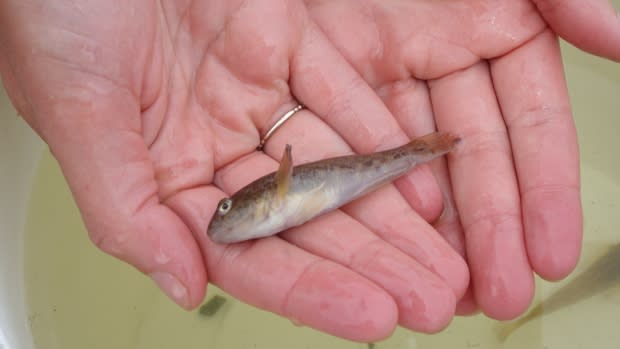Invasive round goby fish found in Rideau Canal

An invasive species of fish originally from the Caspian Sea has been found swimming in the Rideau Canal.
Now, researchers from Carleton University are trying to figure out how the fish got there, and how to prevent them from reaching the Ottawa River.
Round goby fish were found this spring at the Edmonds lockstation in Smiths Falls, Ont. When it was drained, 17 of the invasive fish were spotted.
The discovery caught the attention of researchers at Carleton University, who want to understand their movement patterns through lock systems as part of a larger project about how locks and dams affect the ecology of the Rideau Canal.

Jordanna Bergman, a PhD student at Carleton's Fish Ecology and Conservation Physiology Lab, is leading the field research and said understanding round goby movement is vital to stopping them from continuing all the way to the Ottawa River.
"Once invasive species have established themselves in an area, it's relatively impossible to eradicate them," Bergman said.
Round goby common in Great Lakes
The round goby is native to Eurasia, particularly the Black and Caspian seas, and was spotted in Lake Ontario in 1998. The species was introduced to the Great Lakes through the ballast water of ships.
It's been destructive because it is more aggressive than native fish and competes for the same food source. It also is known to eat the nest eggs of bass fish, which has negative consequences on bass populations.
Bergman's three-person team has now located 11 round goby fish downstream from the Edmonds lockstation, and she said there's a good chance the fish are upstream as well.
"That means that they probably have come here all the way from Lake Ontario, which would be a very impressive feat for such a small benthic fish," she said. Benthic fish live and feed on or near the bottom of waterways.

The team is also tracking another invasive species — the common carp — and two native species, the northern pike and largemouth bass.
By comparing their movements, the researchers are hoping to find ways to optimize the movements of the native fish while minimizing the movements of invasive species.
Tracking round goby isn't easy
But finding round goby fish to tag and track hasn't been an easy task. According to Bergman, traditional methods of angling and using minnow traps weren't working.
"Because goby are relatively new to the system, we believe they are just in lower densities right now and those two techniques are used for higher-density areas," Bergman said.
On Tuesday, her team started a different approach that has them looking a bit like Ghostbusters.
"We're gobybusters," Bergman joked.

They're using a piece of equipment called an electrofisher. It gets strapped to one person's back and sends electrical shocks into the water, which stuns, but doesn't hurt, all the fish nearby.
The stunned fish are then easily captured in a net.
On their first day of "e-fishing" the team found a round goby.
"So much screaming and shouting, so much excitement," Bergman recalled.
The tagged fish will be tracked for a total of 87 days, just long enough to get through the rest of the navigation season.
"So if we do want to see if they're moving through lockstations, this is our chance to do it right now. We've just captured them in time," Bergman said.


